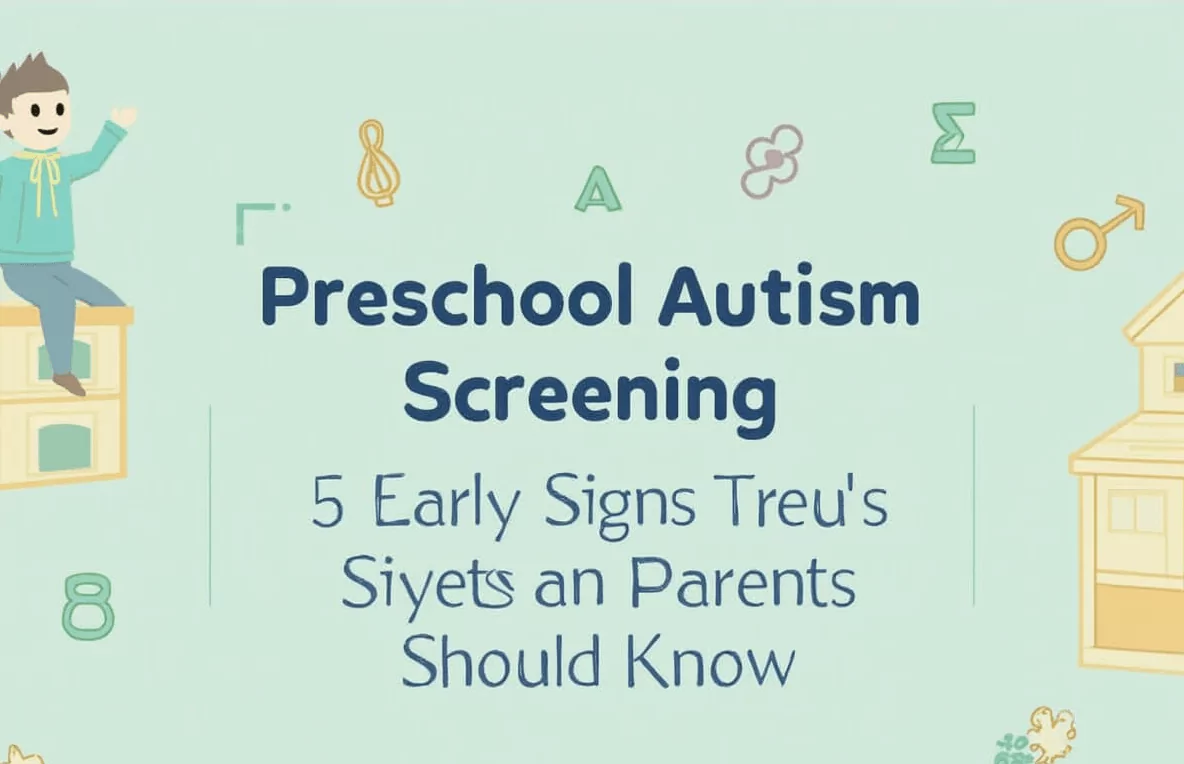With 9 years of experience in the kitchen, I’m passionate about crafting delicious recipes and sharing them with food lovers worldwide. 🍽️✨ Whether it’s a comforting homemade dish or a creative cocktail, my goal is to make cooking fun, easy, and enjoyable for everyone. Join me on this flavorful journey! 🍹🥗

Preschool Autism Screening: 5 Early Signs Parents Should Know
Preschool Autism Screening: 5 Early Signs Parents Should Know
Understanding your child’s development is a primary concern for every parent. Early identification of potential developmental differences, such as autism spectrum disorder (ASD), is crucial. This article explores the importance of early autism detection and highlights key early signs that parents should be aware of.
What Is Preschool Autism Screening?
Early autism detection is a process designed to identify children who may be at risk for autism spectrum disorder (ASD) during their preschool years. Early detection allows for early intervention, which can significantly improve outcomes for children with ASD. To learn more about autism, you can visit Wikipedia’s page on Autism.
Defining Preschool Autism Screening for Modern Audiences
For modern audiences, early autism detection is more than just a simple test. It’s a comprehensive evaluation that includes observation, parent interviews, and sometimes standardized assessments. The goal is to gather enough information to determine if a child needs further evaluation by a specialist. It’s a proactive approach to ensure children receive the support they need as early as possible. We can guide you through this process. Learn more about our services.
The Core Components of Preschool Autism Screening
The core components of effective early autism detection include several key elements. First, developmental monitoring, which involves tracking a child’s progress in various areas, such as communication, social interaction, and motor skills. Second, standardized screening tools like the M-CHAT-R/F (Modified Checklist for Autism in Toddlers, Revised with Follow-Up) are often used. Third, parent interviews provide valuable insights into a child’s behavior and development at home. Finally, professional observation of the child in a structured setting helps clinicians assess social and communication skills. These components are essential for a thorough and reliable screening process. Get in touch with us here for more assistance.
Why Is Preschool Autism Screening Important?
The importance of early autism detection cannot be overstated. Early intervention is critical for maximizing the potential of children with ASD. Identifying ASD early allows for access to specialized therapies, educational support, and behavioral interventions that can significantly improve a child’s social, communication, and cognitive skills. Furthermore, early diagnosis can alleviate parental stress and anxiety by providing a clear understanding of the child’s needs and the resources available to support them.
Key Benefits of Implementing Preschool Autism Screening
Implementing early autism detection programs yields numerous key benefits. Early detection leads to earlier intervention, which is associated with better long-term outcomes. Children who receive early intervention are more likely to develop stronger social and communication skills, achieve greater academic success, and lead more independent lives. Additionally, early screening can reduce the need for more intensive and costly interventions later in life. Early screening benefits everyone and promotes inclusive communities. For more information, visit the CDC’s page on autism screening.
Common Challenges Without Preschool Autism Screening
Without timely early autism detection, children with ASD may face significant challenges. Delayed diagnosis can result in missed opportunities for early intervention, potentially leading to poorer outcomes in social, communication, and academic domains. Children may struggle in school, experience difficulties forming relationships, and face increased rates of anxiety and depression. Furthermore, families may experience increased stress and financial burdens due to the lack of appropriate support and resources. These challenges underscore the critical need for widespread and effective early screening programs. Learn more about us and how we can help.
How to Optimize Preschool Autism Screening for Maximum Results
Optimizing early autism detection involves several key strategies to ensure accurate and effective identification of children at risk for ASD. This includes using validated screening tools, training healthcare professionals and educators on proper screening techniques, and establishing clear referral pathways for further evaluation and intervention.
Step-by-Step Guide to Mastering Preschool Autism Screening
Mastering early autism detection requires a systematic approach. Here’s a step-by-step guide:
- Developmental Monitoring: Regularly observe and track a child’s developmental milestones in areas such as communication, social interaction, and motor skills.
- Parent Input: Gather information from parents through interviews and questionnaires to understand the child’s behavior and development at home.
- Standardized Screening Tools: Utilize validated screening tools like the M-CHAT-R/F to assess the child’s risk for ASD.
- Professional Observation: Observe the child in a structured setting to assess social and communication skills.
- Referral for Evaluation: If the screening suggests a risk for ASD, refer the child to a specialist for further evaluation.
- Early Intervention: If ASD is diagnosed, initiate early intervention services as soon as possible.
Following these steps can significantly improve the accuracy and effectiveness of early autism detection.
Tools and Resources for Enhancing Preschool Autism Screening
Several tools and resources can enhance the effectiveness of early autism detection. The M-CHAT-R/F is a widely used and validated screening tool for toddlers. The Autism Diagnostic Observation Schedule (ADOS) is a standardized assessment used by specialists to diagnose ASD. Parent training programs can empower parents to monitor their child’s development and advocate for their needs. Online resources and support groups provide valuable information and emotional support for families affected by ASD. Utilizing these tools and resources can significantly improve the quality and impact of early screening efforts. Don’t hesitate to contact us with questions.
Future Trends in Preschool Autism Screening
The field of early autism detection is constantly evolving, with new innovations and advancements emerging regularly. Future trends include the use of technology-based screening tools, such as mobile apps and telehealth platforms, to improve access to screening services. Personalized screening approaches that take into account individual risk factors and genetic predispositions are also gaining traction. Advances in neuroscience and biomarker research may lead to the development of objective diagnostic tests for ASD in the future.
Innovations Shaping the Evolution of Preschool Autism Screening
Several innovations are shaping the evolution of early autism detection. Technology-based screening tools, such as mobile apps and telehealth platforms, are making screening more accessible and convenient. Artificial intelligence (AI) is being used to analyze data from screening tools and identify patterns that may indicate ASD. Biomarker research is exploring the potential of using biological markers, such as genetic and metabolic profiles, to diagnose ASD. These innovations hold the promise of improving the accuracy, efficiency, and accessibility of early screening services. We would love to work with you. Learn more about our services.
Preparing Your Strategy for Preschool Autism Screening Advancements
To prepare for advancements in early autism detection, it is essential to stay informed about the latest research and developments in the field. Healthcare professionals and educators should participate in continuing education programs to update their knowledge and skills. Organizations should invest in technology-based screening tools and implement personalized screening approaches. Collaboration between researchers, clinicians, and families is crucial for translating research findings into practical applications. By proactively preparing for these advancements, we can ensure that children with ASD receive the earliest and most effective support possible.
FAQ About Preschool Autism Screening
How Does Preschool Autism Screening Impact Online Visibility?
While early autism detection itself doesn’t directly impact online visibility, content related to it can. Creating informative and accessible online resources about screening practices, early signs of autism, and available support can improve online visibility. By using relevant keywords and optimizing content for search engines, organizations and healthcare providers can reach a wider audience of parents and caregivers seeking information about autism screening. This helps ensure that crucial information is readily available and accessible to those who need it most.
Can Preschool Autism Screening Be Used Across Multiple Industries?
While the primary application of early autism detection is in healthcare and education, the principles of early detection and intervention can be adapted and applied across multiple industries. For example, in the childcare industry, staff can be trained to recognize potential developmental differences and refer children for further evaluation. In the technology industry, developers can create apps and tools that support early screening and intervention efforts. By adapting the principles of early detection and intervention, multiple industries can contribute to improving outcomes for children with ASD.




